
A more recent article on obsessive-compulsive disorder is available.
Am Fam Physician. 2015;92(10):896-903
Author disclosure: No relevant financial affiliations.
Obsessive-compulsive disorder (OCD) is a chronic illness that can cause marked distress and disability. It is a complex disorder with a variety of manifestations and symptom dimensions, some of which are underrecognized. Early recognition and treatment with OCD-specific therapies may improve outcomes, but there is often a delay in diagnosis. Patients can experience significant improvement with treatment, and some may achieve remission. Recommended first-line therapies are cognitive behavior therapy, specifically exposure and response prevention, and/or a selective serotonin reuptake inhibitor (SSRI). Patients with OCD require higher SSRI dosages than for other indications, and the treatment response time is typically longer. When effective, long-term treatment with an SSRI is a reasonable option to prevent relapse. Patients with severe symptoms or lack of response to first-line therapies should be referred to a psychiatrist. There are a variety of options for treatment-resistant OCD, including clomipramine or augmenting an SSRI with an atypical antipsychotic. Patients with OCD should be closely monitored for psychiatric comorbidities and suicidal ideation.
Obsessive-compulsive disorder (OCD) is a neuropsychiatric disorder characterized by recurrent distressing thoughts and repetitive behaviors or mental rituals performed to reduce anxiety. Symptoms are often accompanied by feelings of shame and secrecy. In addition, health care professionals do not always recognize the diverse manifestations of OCD. These factors often lead to a long delay in diagnosis. The average time it takes to receive treatment after meeting diagnostic criteria for OCD is 11 years.1 Primary care physicians can play a crucial role in reducing the burden of OCD through early detection and treatment.
| Clinical recommendation | Evidence rating | References |
|---|---|---|
| Patients with OCD should be monitored for psychiatric comorbidities and suicide risk. | C | 15–17 |
| Cognitive behavior therapy, specifically exposure and response prevention, is the most effective psychotherapy method for treating OCD. | A | 17, 20, 21 |
| SSRIs are recommended as first-line pharmacologic therapy for OCD. | A | 17, 21, 29 |
| A trial of SSRI therapy should continue for 8 to 12 weeks, with at least 4 to 6 weeks at the maximal tolerable dosage. | C | 17 |
| Indefinite SSRI therapy should be considered to prevent OCD relapse. At a minimum, SSRIs should be continued for 1 to 2 years before attempting to discontinue. | C | 17, 22 |
| Augmenting SSRI therapy with an atypical antipsychotic is effective in some patients with OCD who have inadequate response to SSRI therapy. | B | 17, 25, 37 |
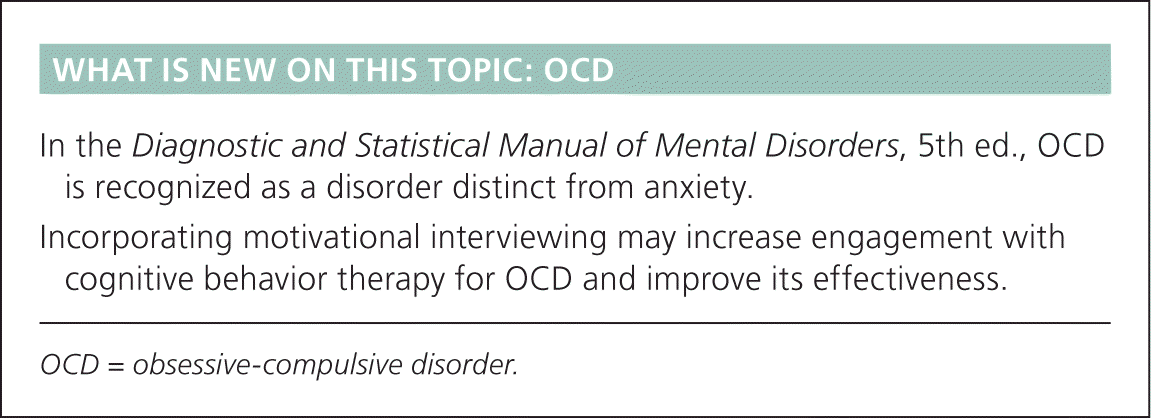
| In the Diagnostic and Statistical Manual of Mental Disorders, 5th ed., OCD is recognized as a disorder distinct from anxiety. |
| Incorporating motivational interviewing may increase engagement with cognitive behavior therapy for OCD and improve its effectiveness. |
Epidemiology
The lifetime prevalence of OCD is 2.3%,2 although this may be an underrepresentation because often only patients with moderate to severe symptoms seek help. The mean age of onset is 19.5 years, and it is rare for new cases of OCD to develop after the early 30s.2 A subset of patients, mostly males, have an early onset (before 10 years of age). The lifetime risk of developing OCD is higher in females, who typically develop the disorder in adolescence.2
Course of Illness
OCD has a substantial effect on quality of life and level of functioning.3 It is often a chronic disorder (60% to 70% of cases) and is likely to persist if not treated effectively.1,4 Significant improvement or remission is possible when evidence-based therapies are applied. Patients with a later age of onset, shorter duration of symptoms, good insight, and response to initial treatment have an increased likelihood of remission.5–7 Early and aggressive treatment of OCD, with a goal of remission, is important for a positive outcome.5 Therefore, it is critical that primary care physicians are equipped to diagnose and treat patients with OCD appropriately. Insufficient treatment and a lack of OCD-specific resources are important problems in the management of this disorder. In one study population, only 30.9% of patients with severe symptoms and 2.9% of patients with moderately severe symptoms received treatment specific for OCD.2
Pathogenesis
The pathogenesis of OCD is a complex interplay between neurobiology, genetics, and environmental influences. Historically, dysfunction in the serotonin system was postulated to be the main factor in OCD pathogenesis, given the selective response to serotonergic medication. More recent research has also demonstrated the role of glutamate, dopamine, and possibly other neurochemicals.8 A proposed model for OCD suggests that genetic vulnerability to environmental stressors may result in modification of gene expression within neurotransmitter systems. This, in turn, results in changes to brain circuitry and function.8
Diagnosis
Obsessions are recurrent intrusive thoughts or images that cause marked distress. The thoughts are unwanted and inconsistent with the individual's sense of self (egodystonic), and great effort is made to resist or suppress them. They can involve contamination; repeated doubts; or taboo thoughts of a sexual, religious, or aggressive nature. Compulsions are repetitive behaviors or mental rituals performed to counteract the anxiety caused by obsessions. Individuals feel strongly compelled to complete these actions, and the behaviors become automatic over time. They can include handwashing, checking, ordering, praying, counting, and seeking reassurance. Common obsessions and compulsions are included in Table 1.9
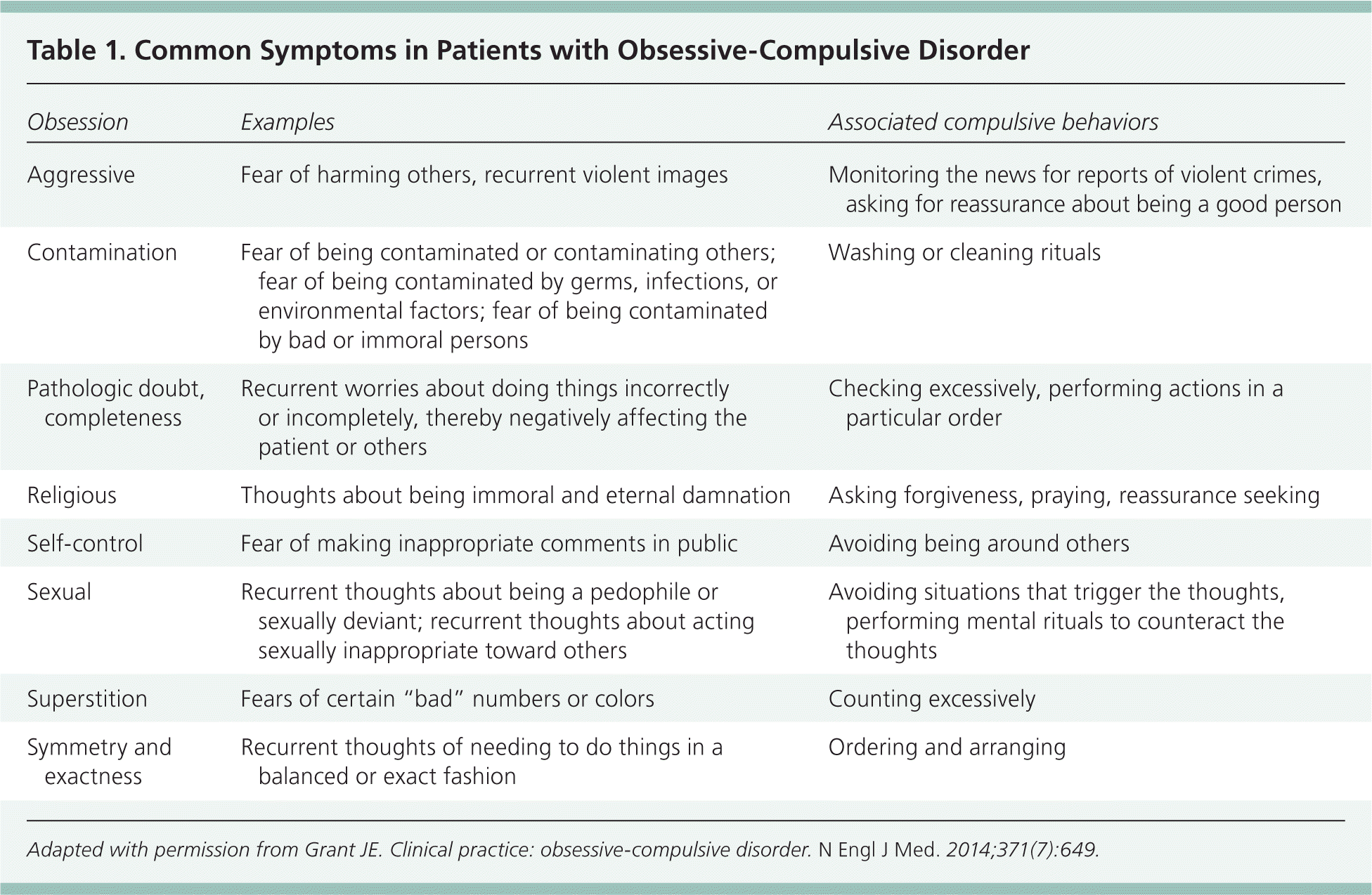
| Obsession | Examples | Associated compulsive behaviors |
|---|---|---|
| Aggressive | Fear of harming others, recurrent violent images | Monitoring the news for reports of violent crimes, asking for reassurance about being a good person |
| Contamination | Fear of being contaminated or contaminating others; fear of being contaminated by germs, infections, or environmental factors; fear of being contaminated by bad or immoral persons | Washing or cleaning rituals |
| Pathologic doubt, completeness | Recurrent worries about doing things incorrectly or incompletely, thereby negatively affecting the patient or others | Checking excessively, performing actions in a particular order |
| Religious | Thoughts about being immoral and eternal damnation | Asking forgiveness, praying, reassurance seeking |
| Self-control | Fear of making inappropriate comments in public | Avoiding being around others |
| Sexual | Recurrent thoughts about being a pedophile or sexually deviant; recurrent thoughts about acting sexually inappropriate toward others | Avoiding situations that trigger the thoughts, performing mental rituals to counteract the thoughts |
| Superstition | Fears of certain “bad” numbers or colors | Counting excessively |
| Symmetry and exactness | Recurrent thoughts of needing to do things in a balanced or exact fashion | Ordering and arranging |
In the Diagnostic and Statistical Manual of Mental Disorders, 5th ed., OCD is recognized as a disorder distinct from anxiety (Table 2) and is now grouped with several other disorders with common features, often referred to as obsessive-compulsive–related disorders (Table 3).10 OCD is a complex, heterogeneous disorder, and some presentations are underrecognized. For example, taboo thoughts may be attributed to other causes or may not appear to be associated with overt compulsions. Even when compulsions are not easily observable, patients with OCD usually have mental rituals. Patients are often reluctant to report symptoms of OCD for a variety of reasons, including embarrassment, stigma, and the fear of what the obsession might mean or the consequences of revealing it.11
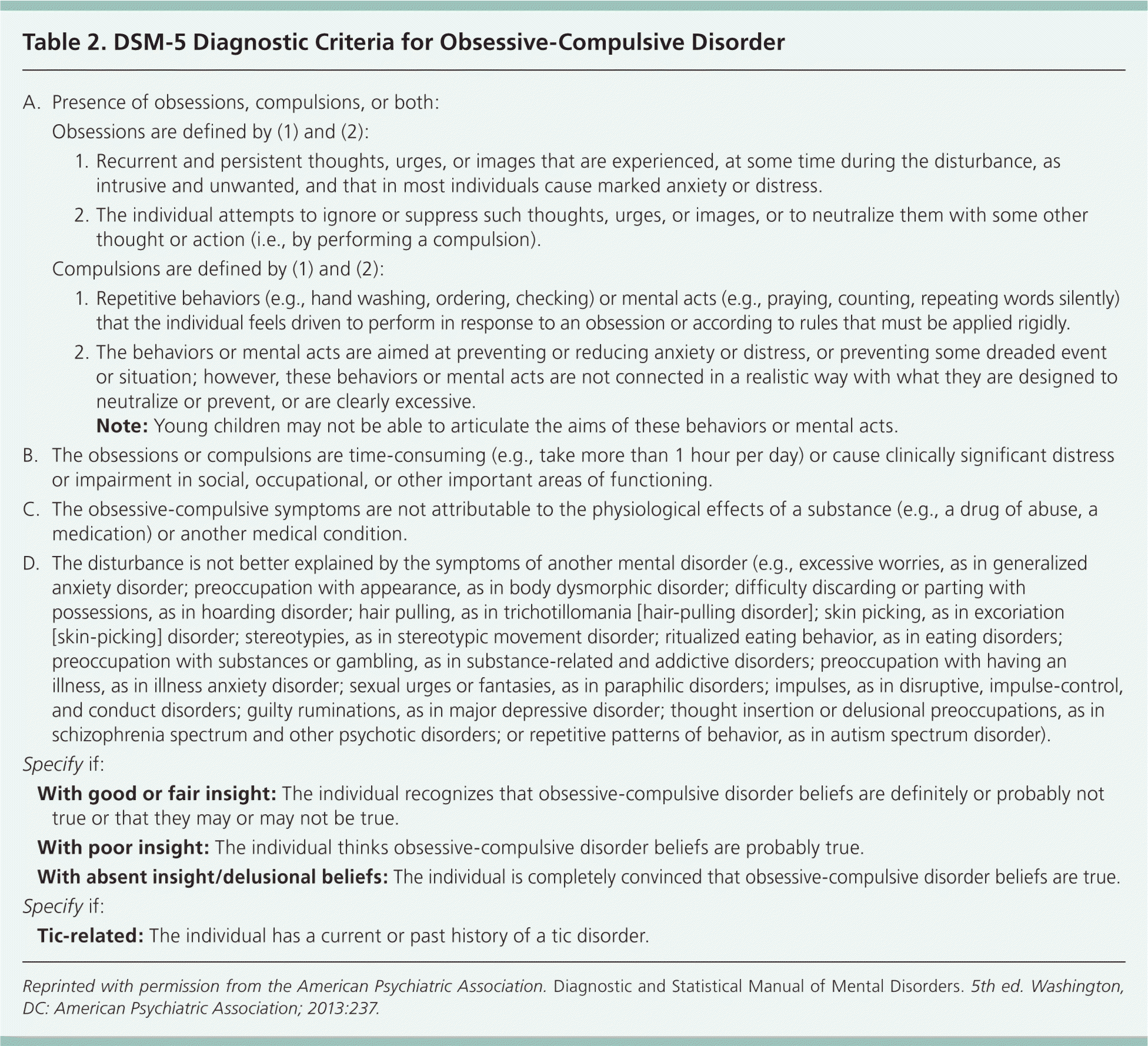
| A. Presence of obsessions, compulsions, or both: | ||
| Obsessions are defined by (1) and (2): | ||
| 1. Recurrent and persistent thoughts, urges, or images that are experienced, at some time during the disturbance, as intrusive and unwanted, and that in most individuals cause marked anxiety or distress. | ||
| 2. The individual attempts to ignore or suppress such thoughts, urges, or images, or to neutralize them with some other thought or action (i.e., by performing a compulsion). | ||
| Compulsions are defined by (1) and (2): | ||
| 1. Repetitive behaviors (e.g., hand washing, ordering, checking) or mental acts (e.g., praying, counting, repeating words silently) that the individual feels driven to perform in response to an obsession or according to rules that must be applied rigidly. | ||
| 2. The behaviors or mental acts are aimed at preventing or reducing anxiety or distress, or preventing some dreaded event or situation; however, these behaviors or mental acts are not connected in a realistic way with what they are designed to neutralize or prevent, or are clearly excessive. | ||
| Note: Young children may not be able to articulate the aims of these behaviors or mental acts. | ||
| B. The obsessions or compulsions are time-consuming (e.g., take more than 1 hour per day) or cause clinically significant distress or impairment in social, occupational, or other important areas of functioning. | ||
| C. The obsessive-compulsive symptoms are not attributable to the physiological effects of a substance (e.g., a drug of abuse, a medication) or another medical condition. | ||
| D. The disturbance is not better explained by the symptoms of another mental disorder (e.g., excessive worries, as in generalized anxiety disorder; preoccupation with appearance, as in body dysmorphic disorder; difficulty discarding or parting with possessions, as in hoarding disorder; hair pulling, as in trichotillomania [hair-pulling disorder]; skin picking, as in excoriation [skin-picking] disorder; stereotypies, as in stereotypic movement disorder; ritualized eating behavior, as in eating disorders; preoccupation with substances or gambling, as in substance-related and addictive disorders; preoccupation with having an illness, as in illness anxiety disorder; sexual urges or fantasies, as in paraphilic disorders; impulses, as in disruptive, impulse-control, and conduct disorders; guilty ruminations, as in major depressive disorder; thought insertion or delusional preoccupations, as in schizophrenia spectrum and other psychotic disorders; or repetitive patterns of behavior, as in autism spectrum disorder). | ||
| Specify if: | ||
| With good or fair insight: The individual recognizes that obsessive-compulsive disorder beliefs are definitely or probably not true or that they may or may not be true. | ||
| With poor insight: The individual thinks obsessive-compulsive disorder beliefs are probably true. | ||
| With absent insight/delusional beliefs: The individual is completely convinced that obsessive-compulsive disorder beliefs are true. | ||
| Specify if: | ||
| Tic-related: The individual has a current or past history of a tic disorder. | ||
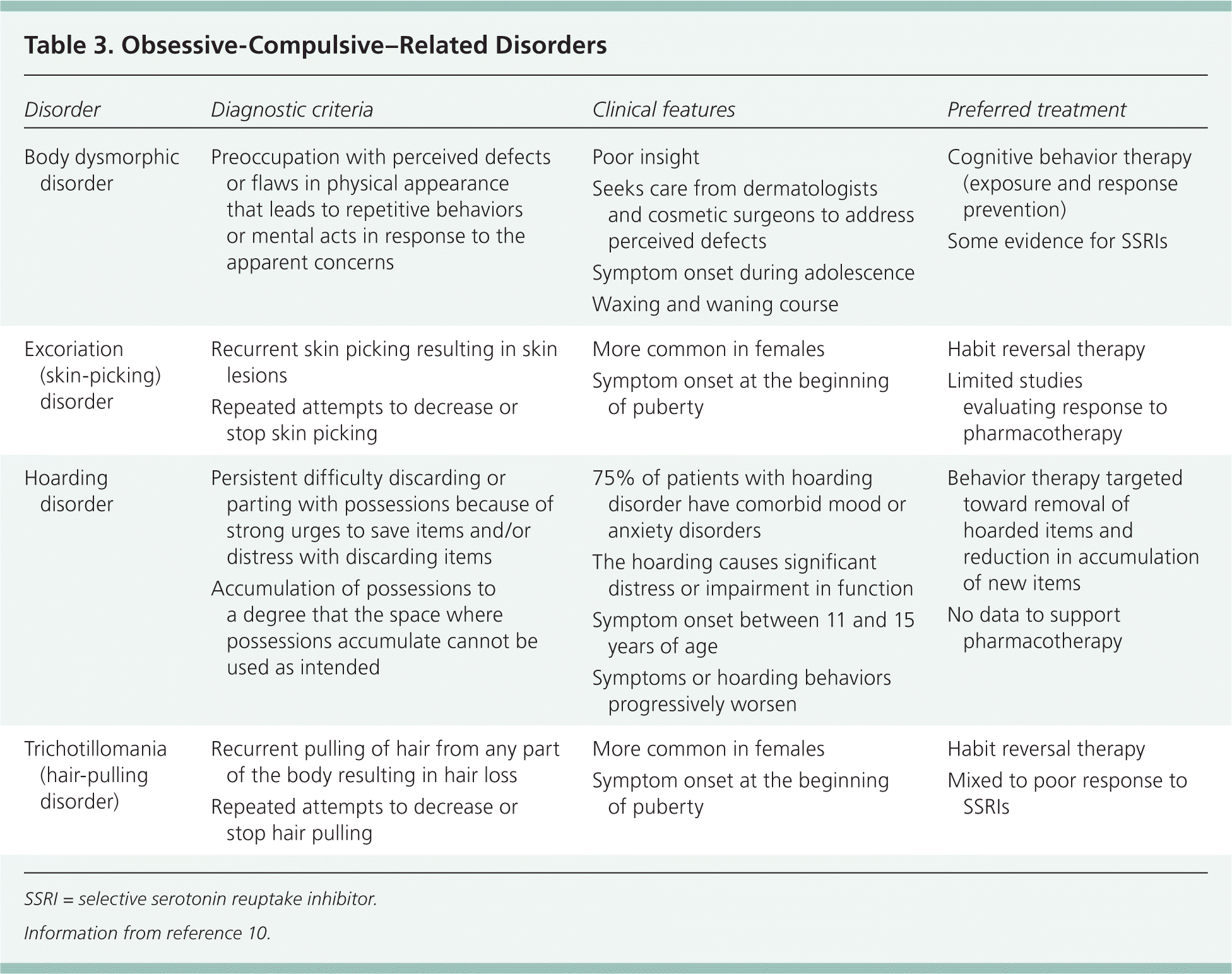
| Disorder | Diagnostic criteria | Clinical features | Preferred treatment |
|---|---|---|---|
|
|
|
|
|
|
|
|
|
|
|
|
|
|
|
|
Physicians should consider the possibility of OCD in patients with general complaints of anxiety or depression. Patients may offer clues by alluding to intrusive thoughts or repetitive behaviors. Avoidance of particular locations or objects, excessive concerns about illness or injury, and repetitive reassurance-seeking behavior are also common. It is important to note that obsessive-compulsive personality disorder is a separate diagnostic entity that is not characterized by intrusive thoughts or repetitive behaviors. Rather, it is a pervasive pattern of behaviors emphasizing organization, perfectionism, and a sense of control.10 If true OCD is suspected, the use of a few simple screening questions can be helpful (Table 4).12 Standardized diagnostic tools are available, but most are not practical for use in primary care. Two commonly used patient self-report inventories are the Obsessive-Compulsive Inventory–Revised13 (http://www.caleblack.com/psy5960_files/OCI-R.pdf) and the Florida Obsessive-Compulsive Inventory 14 (http://www.ocdscales.org/index.php?page=scales).
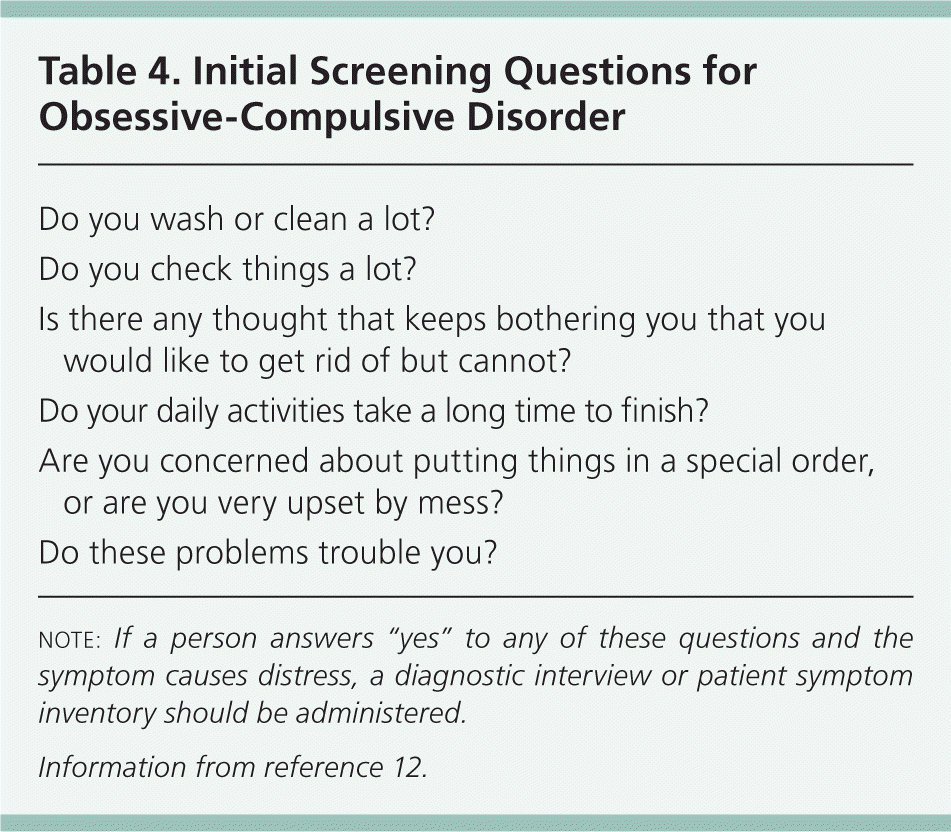
| Do you wash or clean a lot? |
| Do you check things a lot? |
| Is there any thought that keeps bothering you that you would like to get rid of but cannot? |
| Do your daily activities take a long time to finish? |
| Are you concerned about putting things in a special order, or are you very upset by mess? |
| Do these problems trouble you? |
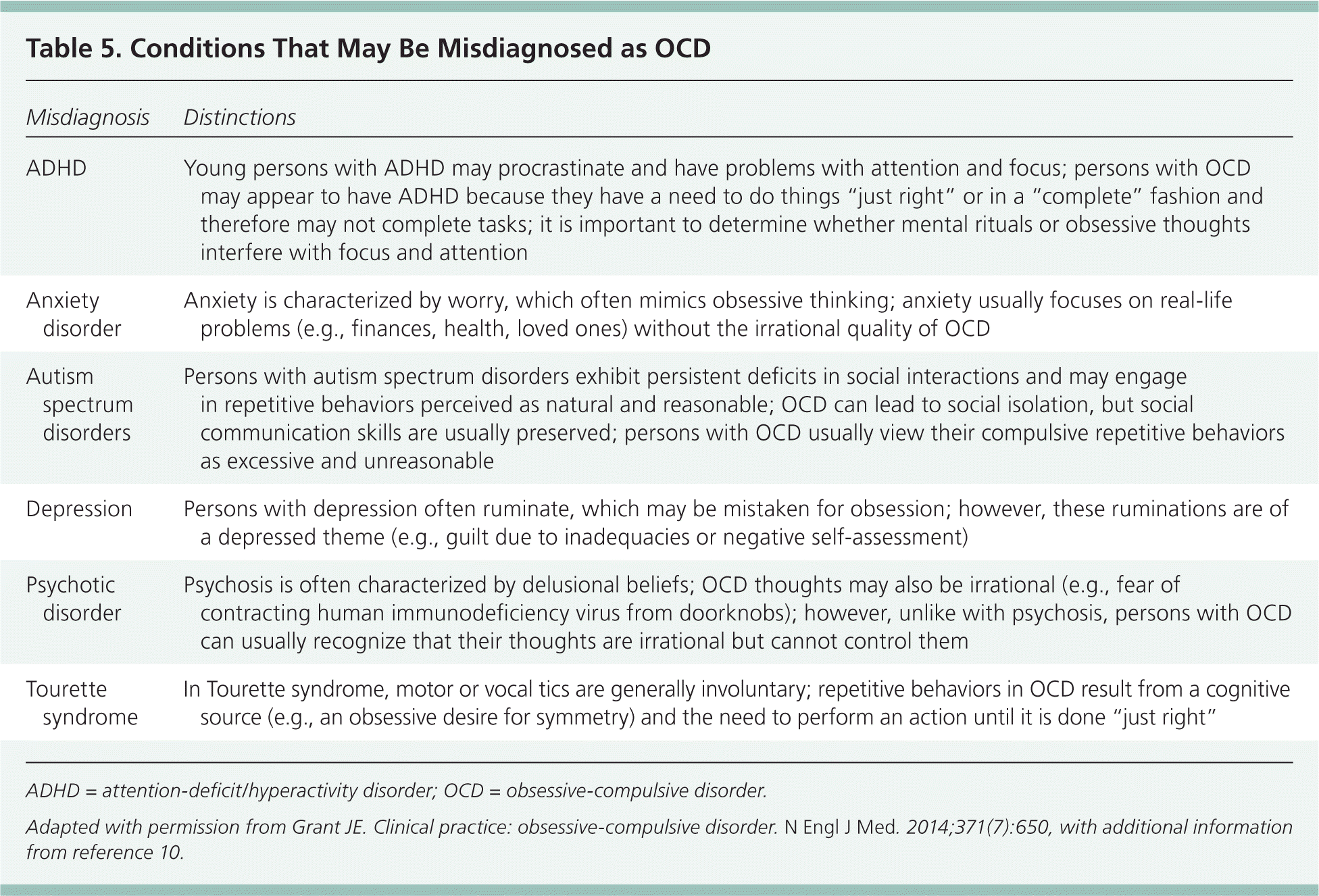
| Misdiagnosis | Distinctions |
|---|---|
| ADHD | Young persons with ADHD may procrastinate and have problems with attention and focus; persons with OCD may appear to have ADHD because they have a need to do things “just right” or in a “complete” fashion and therefore may not complete tasks; it is important to determine whether mental rituals or obsessive thoughts interfere with focus and attention |
| Anxiety disorder | Anxiety is characterized by worry, which often mimics obsessive thinking; anxiety usually focuses on real-life problems (e.g., finances, health, loved ones) without the irrational quality of OCD |
| Autism spectrum disorders | Persons with autism spectrum disorders exhibit persistent deficits in social interactions and may engage in repetitive behaviors perceived as natural and reasonable; OCD can lead to social isolation, but social communication skills are usually preserved; persons with OCD usually view their compulsive repetitive behaviors as excessive and unreasonable |
| Depression | Persons with depression often ruminate, which may be mistaken for obsession; however, these ruminations are of a depressed theme (e.g., guilt due to inadequacies or negative self-assessment) |
| Psychotic disorder | Psychosis is often characterized by delusional beliefs; OCD thoughts may also be irrational (e.g., fear of contracting human immunodeficiency virus from doorknobs); however, unlike with psychosis, persons with OCD can usually recognize that their thoughts are irrational but cannot control them |
| Tourette syndrome | In Tourette syndrome, motor or vocal tics are generally involuntary; repetitive behaviors in OCD result from a cognitive source (e.g., an obsessive desire for symmetry) and the need to perform an action until it is done “just right” |
Comorbidities
Patients with OCD should be monitored for psychiatric comorbidities and suicide risk.15–17 In their lifetime, 90% of patients with OCD meet criteria for at least one other psychiatric diagnosis.2 The most common comorbid diagnoses are anxiety disorders (75.8%), including panic disorder, social phobia, specific phobias, and posttraumatic stress disorder. Other common comorbidities include mood disorders (63.3%), particularly major depressive disorder (40.7%); impulse control disorders (55.9%); and substance use disorders (38.6%).2 The risk of suicide in persons with OCD is high. In one community survey, 63% of persons with OCD had experienced suicidal thoughts, and 26% had attempted suicide.18 Comorbidity with depression, posttraumatic stress disorder, substance abuse, or impulse control disorders increases the risk of suicidal behavior.15,16
Treatment
Once OCD is diagnosed, it is important to provide the patient with information and support. Patients and family members should be educated about the chronic nature of OCD and the importance of self-management skills. Evidence-based medical and behavior therapies can reduce the severity and frequency of obsessions and compulsions, and can induce remission in some patients. Because it may take weeks to months for these therapies to become effective, physicians should inform patients about this delay in treatment response and encourage adherence during the early phase of treatment.
It is helpful to quantify the severity of symptoms and impairment before and during treatment. This may be done using standardized rating scales, or by patient report of the time expended on obsessions or compulsions and the level of distress they cause. The Yale-Brown Obsessive-Compulsive Scale—second edition (Y-BOCS-II) is a reliable tool for measuring OCD symptom severity 19 and is available at http://ericwexlermd.com/MB_PDFs/OCD/YBOCSII.pdf.
Patients should be assessed for suicide risk and presence of comorbidities throughout the course of their illness. Treatment is indicated when OCD symptoms impair the patient's functioning or cause significant distress. Reasonable treatment goals are spending less than one hour per day on obsessive-compulsive behaviors and achieving minimal interference with daily tasks.17 Psychiatric consultation is recommended for patients with severe OCD, as measured by the Y-BOCS-II. Figure 1 is an algorithm for the treatment of OCD.17,20–25
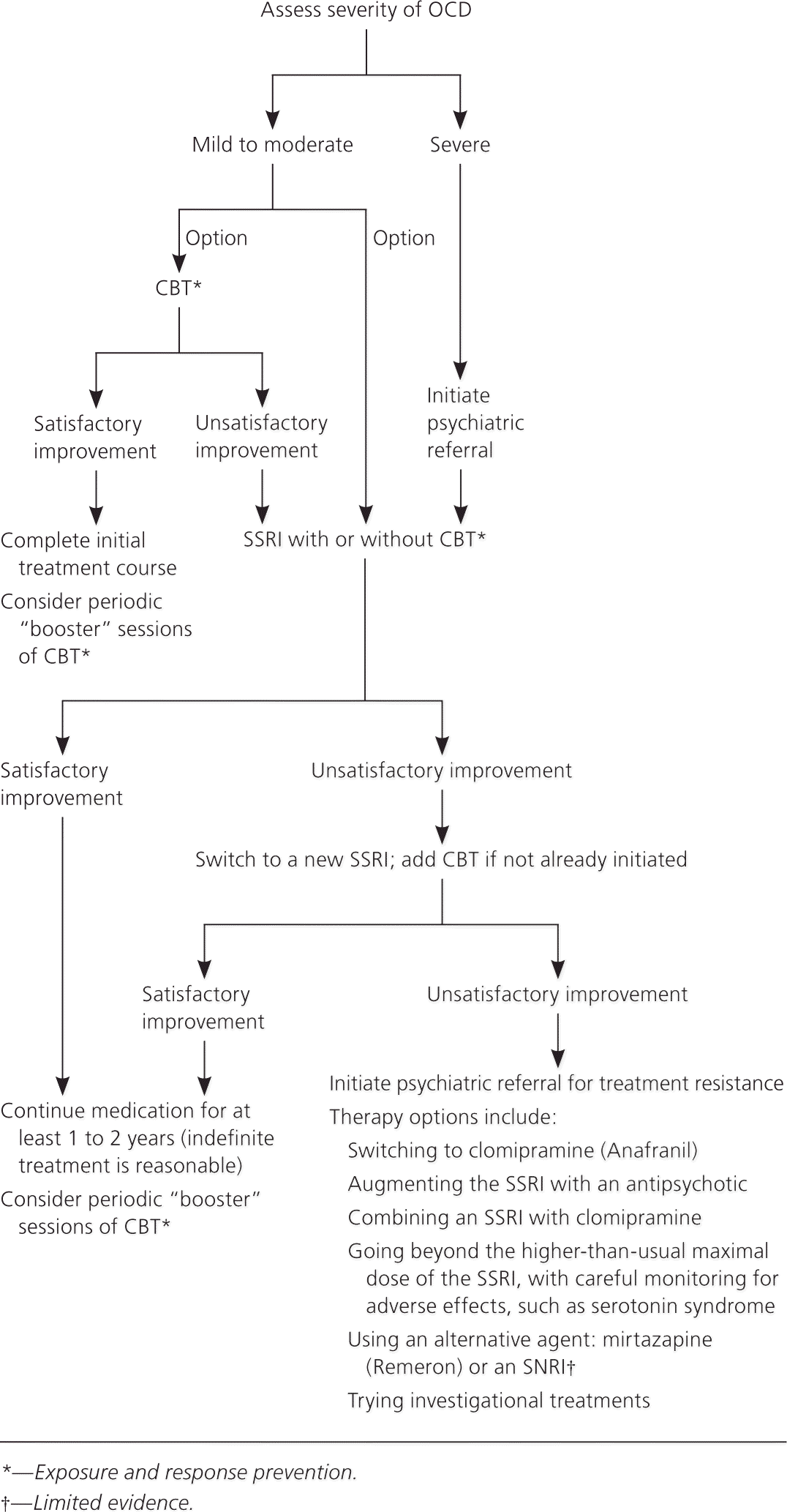
PSYCHOLOGICAL TREATMENTS
Cognitive behavior therapy (CBT), specifically exposure and response prevention, is the most effective psychotherapy method for treating OCD.17,20,21 Patients are exposed to anxiety-provoking stimuli, and learn to not perform compulsive behaviors in response. Ideally, CBT should be administered by a trained health care professional in an individual or group format, although studies have suggested that self-directed exposure and response prevention combined with motivational interviewing may be effective.26,27 Incorporating motivational interviewing may increase engagement with therapy and improve its effectiveness.28 There is no evidence for the use of psychodynamic psychotherapy or “talk therapy” to treat OCD.
PHARMACOTHERAPY
OCD has a highly selective response to serotonergic medications. Clomipramine (Anafranil), a tricyclic antidepressant with a strong serotonergic effect, was previously the first-line pharmacologic treatment for OCD. However, because of concerns about its safety and adverse effects, selective serotonin reuptake inhibitors (SSRIs) are now preferred for initial therapy.17,21 A Cochrane review confirmed the effectiveness of SSRIs for the treatment of OCD (absolute risk reduction = 8% to 17%; number needed to treat = 6 to 12).29 Fluoxetine (Prozac), fluvoxamine, paroxetine (Paxil), and sertraline (Zoloft) have been approved by the U.S. Food and Drug Administration (FDA) for the treatment of OCD. Citalopram (Celexa) and escitalopram (Lexapro) are also commonly used, but in 2011, the FDA began recommending dose limitations for citalopram because of concerns about QT prolongation.30 There is insufficient evidence to show that one SSRI is superior,22 and the choice of SSRI should be individualized, taking into account potential drug interactions and tolerability.
To achieve optimal response, patients with OCD require a higher dosage of an SSRI compared with other indications.17,31 The dosage should be increased over four to six weeks until the maximal dosage is achieved (Table 6).30,32 Higher-than-usual maximal dosages are sometimes used, with careful monitoring for adverse effects such as serotonin syndrome. The trial of therapy should continue for eight to 12 weeks, with at least four to six weeks at the maximal tolerable dosage.17 It usually takes at least four to six weeks for patients to note any significant improvement in symptoms; it may take 10 weeks or longer for some.
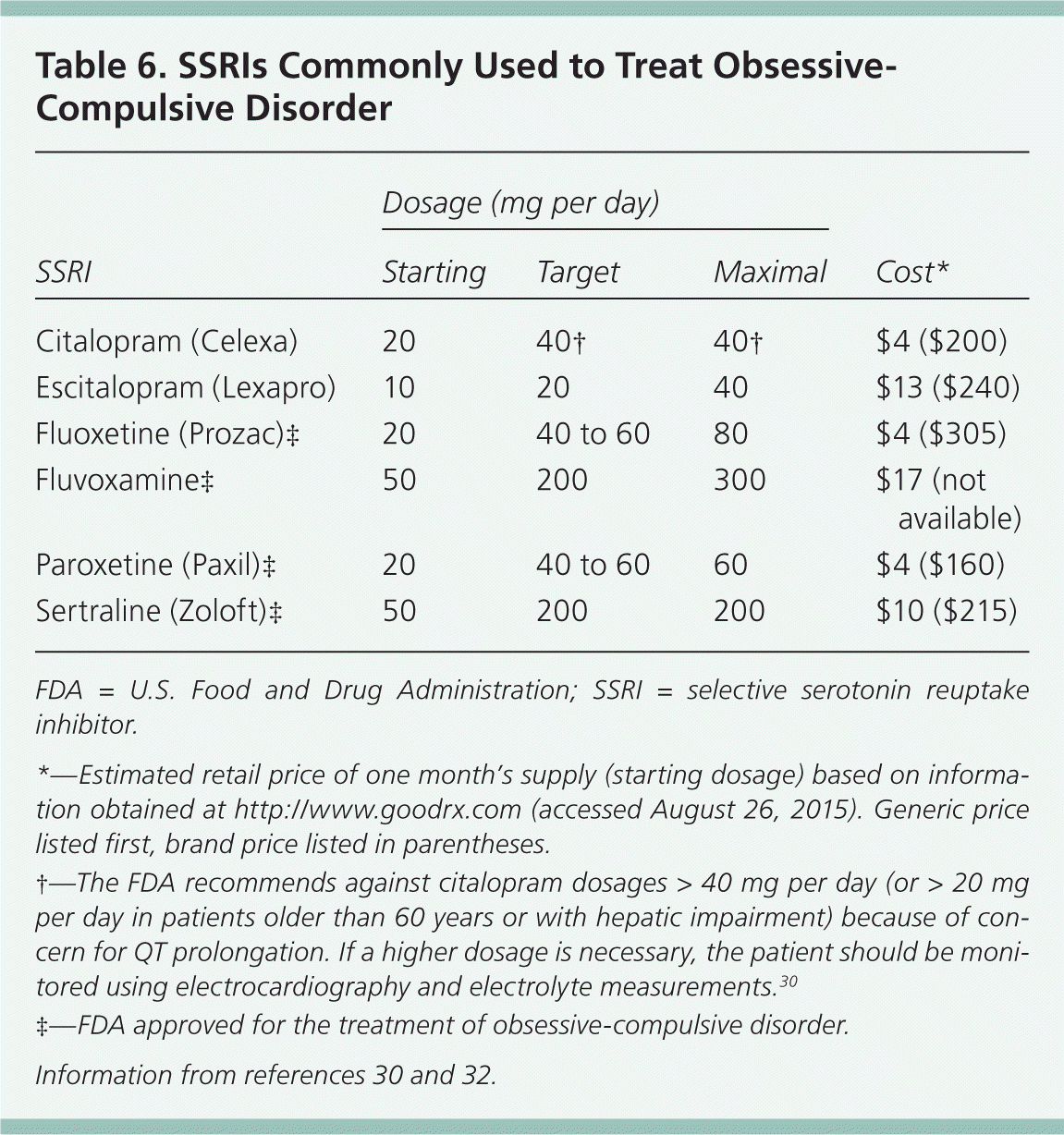
If medical therapy is successful, it should be continued for at least one to two years, if not indefinitely.17,22 Relapse prevention with continuous SSRI therapy is a reasonable treatment goal.33 If the patient chooses to discontinue pharmacotherapy, the dosage should be gradually tapered over several months, and the original dosage resumed if symptoms worsen. The response to psychological treatments may last longer than the response to medications.34 Periodic “booster” sessions of exposure and response prevention are recommended to lower the risk of relapse when psychological therapy is discontinued.17
If an adequate trial of SSRI or psychological therapy does not result in a satisfactory response, combined treatment is an option.35,36 If the patient prefers to continue with medical therapy alone, a trial of a different SSRI is warranted.17 If there is no response to trials of at least two SSRIs, the patient should be referred to a psychiatrist. Clomipramine is an option in these patients.17 Because clomipramine can cause anticholinergic adverse effects, and rarely arrhythmia or seizures, it should be started at a low dosage (25 mg per day) with gradual titration to minimize adverse reactions. Addition of an atypical antipsychotic is effective for some patients with inadequate response to SSRI therapy.17,25,37 There is conflicting evidence regarding which atypical antipsychotic agent is most effective, and the usefulness of these medications is offset by a higher risk of adverse effects than SSRI monotherapy.25
There are a variety of other options for patients with treatment-resistant OCD, but the evidence for most therapies is limited. Some studies support the effectiveness of serotonin-norepinephrine reuptake inhibitors or mirtazapine (Remeron) for OCD.38-40 Other medications under investigation include glutamatergic agents, stimulants, pindolol, ondansetron (Zofran), acetylcysteine, and anticonvulsants.23–25 Deep brain stimulation has had promising results for severe treatment-resistant OCD, but it has been studied in only a small number of patients. This treatment is used as a last resort and has received limited FDA approval under the humanitarian device exemption.41
Special Populations
PREGNANCY AND POSTPARTUM
Women who are pregnant or in the postpartum period are 1.5 to 2 times more likely to experience OCD compared with the general female population.42 Women who had OCD before pregnancy may have worsening OCD symptoms and are at higher risk of postpartum depression.42–44 Postpartum OCD may manifest as intrusive thoughts of harming the infant; however, these women are not at increased risk of injuring their infants.42 CBT is recommended as first-line treatment for OCD during pregnancy and the postpartum period. An individual risk-benefit analysis should be discussed when considering SSRI therapy during pregnancy and lactation.44
CHILDREN
The prevalence of childhood OCD is 1% to 2% in the United States, and 50% of these children have comorbid psychiatric conditions. CBT with exposure and response prevention is the preferred initial treatment for mild to moderate cases.45 Family involvement is important for successful outcomes.45,46 Treatment with SSRIs, in addition to CBT, is indicated for patients with severe symptoms or comorbid psychiatric conditions limiting CBT participation. CBT with or without medication is superior to medication alone for treatment of childhood OCD.47
Abrupt onset of obsessive-compulsive symptoms in children may raise concern for pediatric autoimmune neuropsychiatric disorders associated with streptococcal infection (PANDAS). The term PANDAS is falling out of favor because of controversy regarding the etiologic role of group A streptococcal infection. A proposed new label for this diagnosis is childhood acute neuropsychiatric symptoms (CANS).48 CANS has many proposed etiologic factors, including infectious, toxic, and metabolic causes. There are currently no standard guidelines for the management of CANS, but a comprehensive evaluation is recommended, and empiric antibiotics are not indicated.48
Data Sources: A PubMed search was completed using the key term obsessive-compulsive disorder, as well as individual components of the term. The search included meta-analyses, randomized controlled trials, and practice guidelines within the previous five years. Also searched were the Cochrane database, Database of Abstracts of Reviews of Effects, BMJ Clinical Evidence, National Guideline Clearinghouse database, and Essential Evidence Plus. We performed multiple targeted searches in PubMed and of reference lists of previously retrieved articles to further research specific topics, such as course of illness, pathogenesis, suicidality, and special populations. Search dates: October to December 2014, and September 2015.
note: This review updates a previous article on this topic by Fenske and Schwenk.49
